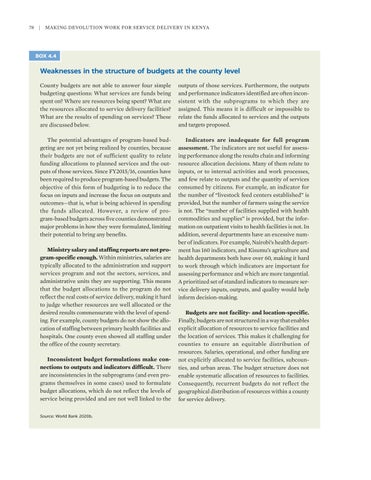78
|
Making Devolution Work for Service Delivery in Kenya
BOX 4.4
Weaknesses in the structure of budgets at the county level County budgets are not able to answer four simple budgeting questions: What services are funds being spent on? Where are resources being spent? What are the resources allocated to service delivery facilities? What are the results of spending on services? These are discussed below.
outputs of those services. Furthermore, the outputs and performance indicators identified are often inconsistent with the subprograms to which they are assigned. This means it is difficult or impossible to relate the funds allocated to services and the outputs and targets proposed.
The potential advantages of program-based budgeting are not yet being realized by counties, because their budgets are not of sufficient quality to relate funding allocations to planned services and the outputs of those services. Since FY2015/16, counties have been required to produce program-based budgets. The objective of this form of budgeting is to reduce the focus on inputs and increase the focus on outputs and outcomes—that is, what is being achieved in spending the funds allocated. However, a review of program-based budgets across five counties demonstrated major problems in how they were formulated, limiting their potential to bring any benefits.
Indicators are inadequate for full program assessment. The indicators are not useful for assessing performance along the results chain and informing resource allocation decisions. Many of them relate to inputs, or to internal activities and work processes, and few relate to outputs and the quantity of services consumed by citizens. For example, an indicator for the number of “livestock feed centers established” is provided, but the number of farmers using the service is not. The “number of facilities supplied with health commodities and supplies” is provided, but the information on outpatient visits to health facilities is not. In addition, several departments have an excessive number of indicators. For example, Nairobi’s health department has 160 indicators, and Kisumu’s agriculture and health departments both have over 60, making it hard to work through which indicators are important for assessing performance and which are more tangential. A prioritized set of standard indicators to measure service delivery inputs, outputs, and quality would help inform decision-making.
Ministry salary and staffing reports are not program-specific enough. Within ministries, salaries are typically allocated to the administration and support services program and not the sectors, services, and administrative units they are supporting. This means that the budget allocations to the program do not reflect the real costs of service delivery, making it hard to judge whether resources are well allocated or the desired results commensurate with the level of spending. For example, county budgets do not show the allocation of staffing between primary health facilities and hospitals. One county even showed all staffing under the office of the county secretary. Inconsistent budget formulations make connections to outputs and indicators difficult. There are inconsistencies in the subprograms (and even programs themselves in some cases) used to formulate budget allocations, which do not reflect the levels of service being provided and are not well linked to the Source: World Bank 2020b.
Budgets are not facility- and location-specific. Finally, budgets are not structured in a way that enables explicit allocation of resources to service facilities and the location of services. This makes it challenging for counties to ensure an equitable distribution of resources. Salaries, operational, and other funding are not explicitly allocated to service facilities, subcounties, and urban areas. The budget structure does not enable systematic allocation of resources to facilities. Consequently, recurrent budgets do not reflect the geographical distribution of resources within a county for service delivery.


